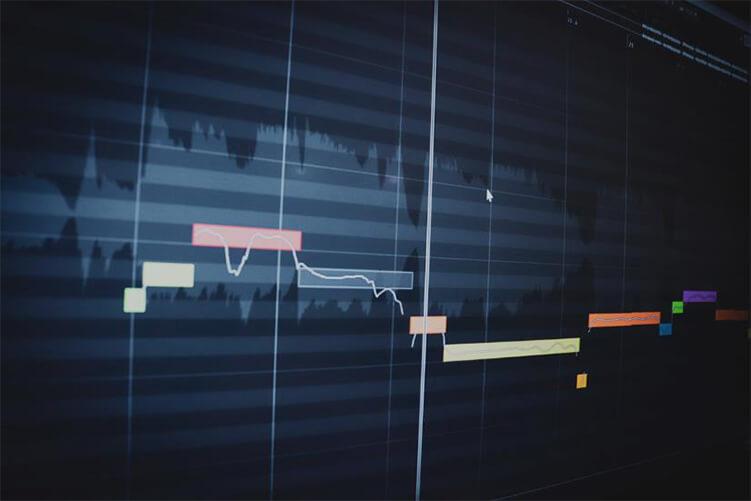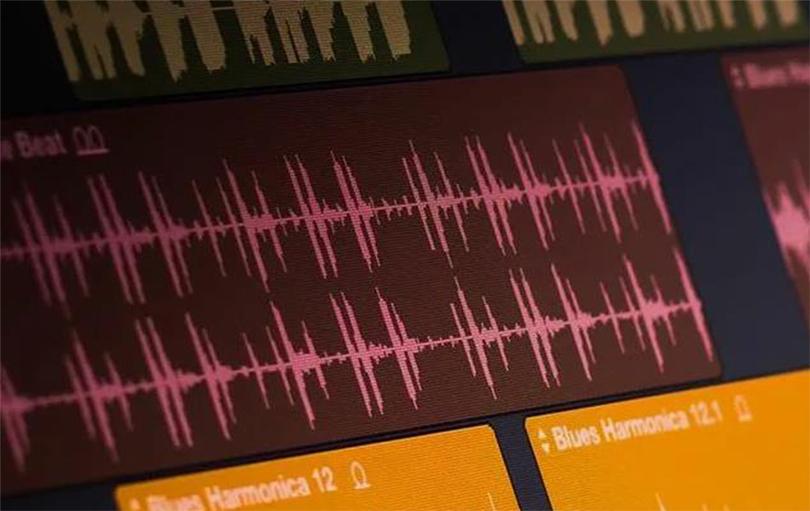Double harmonic scale

The double harmonic major scale is one of the most unusual scales available for improvisation and composition. It is also called the Byzantine or Gypsy major scale. It is rarely used in Western music due to its unique set of intervals. This scale is a great choice for those looking to create a unique sound, and is especially popular with metal musicians and film composers. Jazz musicians can also use it to create a more “experimental” sound. The scale may seem dissonant at first, but over time you will appreciate its uniqueness and be able to add this sound to your musical palette.

A true treasure among musical scales, the double harmonic scale is distinguished by its unique set of notes and intervals. Often referred to as the Byzantine scale, this scale has a distinctive sound that has influenced many genres of music. What makes this scale special is the augmented second between the second and third notes, which sets it apart from the more familiar major and minor scales.
At its core, the double harmonic scale is built on a sequence of notes that create a sound that is rich in cultural traditions. This seven-note scale is often associated with the music of the Middle East, but has also found its way into Western compositions. It offers a combination of exotic tones and traditional melodies.
The key to understanding this scale is its note structure, which is a mixture of augmented, major, and minor intervals. For digital music producers, the double harmonic scale opens up a wide range of creative possibilities. By using this scale in your compositions, you can give your music a unique character that will make it stand out from the rest.
Let’s analyze the double harmonic major scale
The Double Harmonic Major Scale is a variation of the Double Harmonic scale that emphasizes major intervals and tones. This scale is based on a modification of the traditional major scale by adding certain augmented and minor intervals, giving it a sound that is both familiar and intriguing.
The Double Harmonic Major scale combines the brightness of the classic major scale with the exotic elements of Eastern musical traditions. In this scale, the augmented second plays a key role, especially between the second and third notes, such as E and F in C major. This interval adds drama to the music and distinguishes the Double Harmonic Major scale from the standard major scale.
This scale is a great tool for adding a unique sound to your tracks. The application of the double harmonic major scale is not only about the use of specific notes, but also how those notes interact to create a certain mood and atmosphere. The tension and release created by the augmented second can be used to increase the tension in a track or to add emotional depth. It is these note interactions that make the double harmonic major scale a valuable asset in the digital music producer’s arsenal.
Details about the double harmonic major scale
The steps in the double harmonic scale are:
- semitone, augmented second, semitone, whole tone, semitone, augmented second, semitone.
Or, in the context of the tonic chord:
- minor second, major third, perfect fourth, perfect fifth, minor sixth, major seventh, octave.
The scale is usually represented in such a way that the first and last semitones are replaced by quarter tones.
The form without quarter tones coincides with the North Indian thaat called Bhairav and the South Indian (Carnatic) Melakartan mode called Mayamalavagovla.
The double harmonic scale can be obtained in several ways:
- by lowering the second and sixth degrees of the Ionian mode by a semitone;
- by lowering the second degree and raising the third degree of the harmonic minor scale by a semitone;
- by raising the seventh of the Phrygian dominant (the mode of the harmonic minor scale) by a semitone. The Phrygian dominant, in turn, is obtained by raising the third of the diatonic Phrygian mode (the major mode) by a semitone;
- by raising the third of the Neapolitan minor scale by a semitone;
- by lowering the second degree of the harmonic major scale by a semitone;
- by combining the lower half of the Phrygian dominant scale with the upper half of the harmonic minor.
It is called the “double harmonic” scale because it contains two harmonic tetrads with augmented seconds. In contrast, the harmonic major and harmonic minor scales contain only one augmented second between the sixth and seventh degrees.
There is a variation of the double harmonic major scale called the Double Harmonic Major b7, which is also the fifth mode of the harmonic minor scale. It is sometimes confused with the double harmonic major scale, as many sources simply call it “double harmonic major” without specifying the b7. The main difference between the two scales is the seventh degree: in the Double Harmonic Major b7, the seventh degree is lowered (♭7), while in the double harmonic major scale, the seventh degree is natural.
The scale includes a built-in tritone substitution, a dominant seventh chord a semitone above the root, with a strong movement toward the tonic chord.
The double harmonic scale is rarely used in Western classical music, as it does not follow any of the major modes and is not easily derived from them. It is also difficult to integrate into traditional Western chord progressions such as the authentic cadence, as it is primarily used as a modal scale, not intended to move significantly through chord changes.
Symmetry and balance
The double harmonic scale is unique in its radial symmetry, that is, symmetry around the root or central note. If this symmetry is broken by changing the second or seventh tone by a semitone, one obtains the harmonic major scale or the Phrygian dominant of the harmonic minor scales, respectively. Unlike the double harmonic minor scale, these variants contain a full diminished chord.
This scale, as well as its derivatives such as the Hungarian minor scale, is the only seven-note scale (in 12-tone equal temperament) that has perfect balance. This means that if its pitches are represented as points on a circle (where a full circle corresponds to an octave), then the average position of these points (or “center of mass”) coincides with the center of the circle.
Double Harmonic Major Scale: 5 Positions
Now that we have covered the basics of the scale, let’s move on to learning how to play it. Let’s start with the first position:
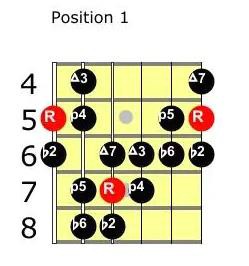
Another key feature of this scale is the successive semitones between the 7th, the root, and the lowered 2nd. This gives the double harmonic major scale its unique sound, although it may seem too dissonant to some. Now, after the first position, let’s move on to the second:
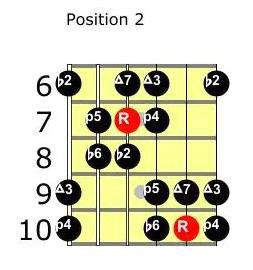
Although position 2 can present some difficulties, with practice these can be overcome. After position 2 comes position 3, which begins with the major third of the scale:
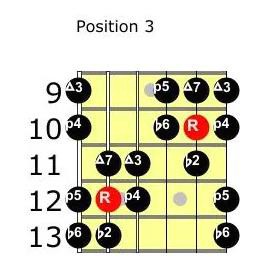
Next comes position 4, starting from the 5th degree:

Finally, here is position 5, starting on the 7th scale degree:
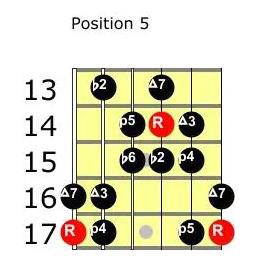
22nd Fret Diagram
While it will take some time to work through the 5 positions of this scale, it is important to find your preferred fingerings using the full fretboard diagram. Here is the full A double harmonic major scale chart. Also note the use of open strings:
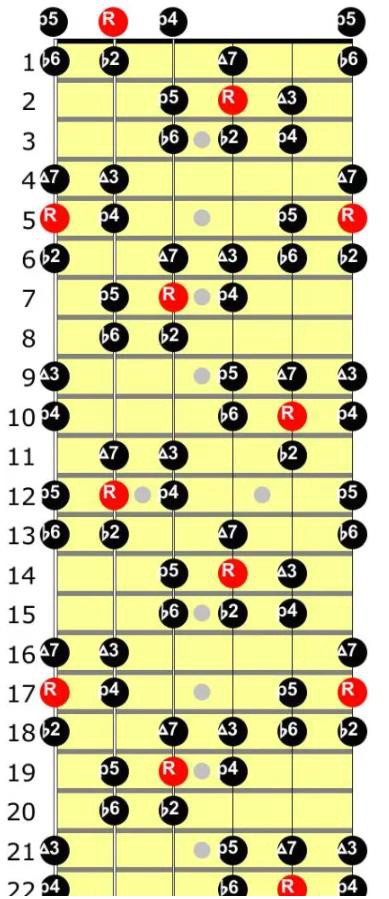
Now that you have mastered this scale in the key of A, your next task is to learn it in all 12 keys.


